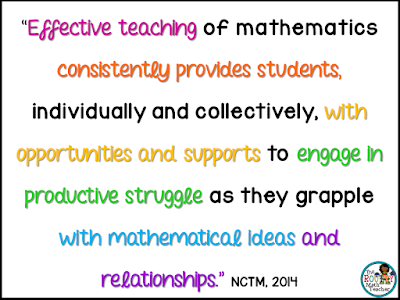
Thank you for joining me for week two of Summer PD! For the next three weeks, I will be talking about productive struggle and how we can use it to promote a growth mindset for our students. Part I of this mini-series will define productive struggle, advocate for its purpose and usefulness in the classroom, and illustrate how it is reflected in a teacher's instructional decisions.
Imagine two sixth grade classrooms with two teachers, Mrs. K and Ms. S, who are presenting the following problem solving task:
Farmer Brown’s niece Angie is in charge of her uncle’s farm while he is on vacation. He gave her strict instructions to make sure none of the animals ran away. When Angie counted the cows, chickens, and sheep, she counted 96 animals. There were three times as many chickens as cows and twice as many sheep as cows. How many sheep did she count?As soon as each teacher presents the problem, the students begin to show signs of struggle and the teachers overhear several students say that they do not know what to do.
Ms. S is very prescriptive in her response. She tells the students to draw a strip diagram and use pictures to represent the number of animals when compared to the cows. She then instructs them to label the entire rectangle as 96 to represent the total number of animals. The picture below shows an example of the strip diagram created by Ms. S. Finally, she instructs the students to use the diagram to determine the number of each kind of animal.
 |
| Clipart by Pink Cat Studio |
As a result of the teachers' instructional decisions, the students have had very different learning experiences. While Ms. S used a prescriptive approach to direct the students' thinking and lead them to the correct solution path, Mrs. K helped the students analyze the problem and encouraged them to choose a starting place at which to begin. Ms. S's students have learned that if they are stuck and can't move forward, Ms. S will rescue them. Mrs. K's students have learned that when they are stuck and need help to move forward, Mrs. K will give them some support to help get them back on track.
Mrs. K's instructional decisions displayed in the vignette supports students "struggling productively as they learn mathematics" (p. 48). The National Council of Teachers of Mathematics (NCTM) states that Mrs. K's classroom instruction "embraces a view of students' struggles as opportunities for delving more deeply into understanding the mathematical structure of problems and relationships among mathematical ideas, instead of simply seeking correct solutions" (p. 48). NCTM also suggests that using productive struggle in the classroom has long-term benefits that will allow students to apply their learning in a variety of new situations and contexts.
Reference: National Council of Teachers of Mathematics. (2014). Principles to actions: Ensuring mathematical success for all. Reston, VA: National Council of Teachers of Mathematics.

















You write such helpful posts. Thank you.
ReplyDelete